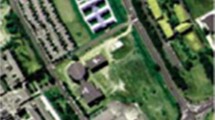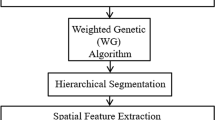Abstract
Imaging spectroscopy integrates conventional imaging and spectroscopy to attain both spatial and spectral information from an object. Processing and analysis of a hypercube can be a hard task. Robust methods for hyperspectral data classification are required, insensitive to imaging deficiencies and high input dimension. Mushrooms have a thin and porous epidermal structure, and are sensitive to handling and transportation practices. Mechanical damage triggers a browning process within the tissue changing its metabolic state. The objective is to quantify different levels of physical perturbation on the mushroom pilei, using near-infrared spectral images and machine learning approaches. An ANN classifier is implemented, whose input is a small set of vectors containing representative information, and output is the set of categorical labels that correspond to different levels of mechanical vibration. For obtaining a salient dataset for classifying the images, the Harris corner detection algorithm is employed. The advantage of using interest points is to replace an exhaustive search over the entire image space by a computation over a concise set of highly informative points. A frame-based classification approach is proposed and shown to produce an increase in the classification accuracy, since feature vectors regarded as single instances may not always carry sufficient discriminant information. Comparisons with statistical features computed from wavelet coefficients showed that interest points are more suitable in assessing mechanical perturbation. Comparisons on a classifier level with support vector machines showed that ANNs perform better for the specific application, implying a connection between the classification method and the underlying learning problem. Overall, the frame-based classification scheme reduced the misclassification rate. This approach is suited for challenging classification problems where the degree of class separation is variable, i.e., assessment of mechanical damage in mushrooms.





Similar content being viewed by others
References
Gowen AA, O’Donnell CP, Cullen PJ, Downey G, Frias JM (2007) Hyperspectral imaging—an emerging process analytical tool for food quality and safety control. Trends Food Sci Tech 18:590–598
Kerekes JP, Schott JR (2007) Hyperspectral imaging systems. In: Chang CI (ed) Hyperspectral data exploitation: theory and applications. Wiley, Hoboken, pp 19–46
Mukherjee A, Velez-Reyes M, Roysam B (2009) Interest points for hyperspectral image data. IEEE T Geosci Remote 47:748–760
Camps-Valls G, Gomez-Chova L, Calpe-Maravilla J, Martin-Guerrero JD, Soria-Olivas E, Alonso-Chorda L, Moreno J (2004) Robust support vector method for hyperspectral data classification and knowledge discovery. IEEE Trans Geosci Remote 42:1530–1542
Dai Q, Sun D-W, Xiong Z, Cheng J-H, Zheng X-A (2014) Recent advances in data mining techniques and their applications in hyperspectral image processing for the food industry. Compr Rev Food Sci F 13:891–905
Dai Q, Cheng J-H, Sun D-W, Zeng X-A (2015) Advances in feature selection methods for hyperspectral image processing in food industry applications: a review. Crit Rev Food Sci Nutr 55:1368–1382
Gowen AA, Tsenkova R, Esquerre C, Downey G, O’Donnell CP (2009) Use of near infrared hyperspectral imaging to identify water matrix co-ordinates in mushrooms (Agaricus bisporus) subjected to mechanical vibration. J Near Infrared Spectrosc 17:363–371
Esquerre C, Gowen AA, O’Donnell CP, Downey G (2009) Water absorbance pattern of physically-damaged mushrooms stored at ambient conditions. J Near Infrared Spectrosc 17:353–361
Chang ST, Miles PG (2004) Mushrooms: cultivation, nutritional value, medicinal effect and environmental impact. CRC Press, Boston
Esquerre C, Gowen AA, O’Donnell CP, Downey G (2009) Initial studies on the quantitation of bruise damage and freshness in mushrooms using visible-near-infrared spectroscopy. J Agric Food Chem 57:1903–1907
Jolivet S, Arpin N, Wichers HJ, Pellon G (1998) Agaricus bisporus browning: a review. Mycol Res 102:1459–1483
O’Gorman A, Barry-Ryan C, Frias JM (2012) Evaluation and identification of markers of damage in mushrooms (Agaricus bisporus) postharvest using a GC/MS metabolic profiling approach. Metabolomics 8:120–132
Ortiz C, Blasco J, Balasch S, Torregrosa A (2011) Shock absorbing surfaces for collecting fruit during the mechanical harvesting of citrus. Biosyst Eng 110:2–9
ElMasry G, Wang N, Vigneault C, Qiao J, ElSayed A (2008) Early detection of apple bruises on different background colors using hyperspectral imaging. LWT–Food. Sci Technol 41:337–345
Jiménez-Jiménez F, Castro-García S, Blanco-Roldán GL, Agüera-Vega J, Gil-Ribes JS (2012) Non-destructive determination of impact bruising on table olives using Vis–NIR spectroscopy. Biosyst Eng 113:371–378
Van Zeebroeck M, Tijskens E, Van Liedekerke P, Deli V, De Baerdemaeker J, Ramon H (2003) Determination of the dynamical behaviour of biological materials during impact using a pendulum device. J Sound Vib 266:465–480
Hahn F (2004) Mango firmness sorter. Biosyst Eng 89:309–319
Rivera NV, Gómez-Sanchis J, Chanona-Pérez J, Carrasco JJ, Millán-Giraldo M, Lorente D, Cubero S, Blasco J (2014) Early detection of mechanical damage in mango using NIR hyperspectral images and machine learning. Biosyst Eng 122:91–98
Blasco J, Aleixos N, Gómez-Sanchis J, Moltó E (2009) Recognition and classification of external skin damages in citrus fruits using multispectral data and morphological features. Biosyst Eng 103:137–145
Nanyam Y, Choudhary R, Gupta L, Paliwal J (2012) A decision-fusion strategy for fruit quality inspection using hyperspectral imaging. Biosyst Eng 111:118–125
Burger J, Gowen AA (2011) Data handling in hyperspectral image analysis. Chemometr Intell Lab 108:13–22
Harris C, Stephens M (1998) A combined corner and edge detector. In: Proceedings of the 4th Alvey vision conference. pp 147–151
Lunga D, Prasad S, Crawford MM, Esroy O (2014) Manifold-learning-based feature extraction for classification of hyperspectral data: a review of advances in manifold learning. IEEE Signal Proc Mag 31:55–66
Sebe N, Lew MS (2003) Comparing salient point detectors. Pattern Recogn Lett 24:89–96
Chen L, Lu W, Ni J, Sun W, Huang J (2013) Region duplication detection based on Harris corner points and step sector statistics. J Vis Commun Image Represent. 24:244–254
Kulkarni AD (2001) Computer vision and fuzzy-neural systems. Prentice-Hall, New Jersey
Plaza J, Plaza A, Pérez R, Martínez P (2008) Parallel classification of hyperspectral images using neural networks. In: Grana M, Duro RJ (eds) Computational intelligence for remote sensing. Springer, Berlin, pp 193–216
Li Y, Rad AB, Peng W (1999) An enhanced training algorithm for multilayer neural networks based on reference output of hidden layer. Neural Comput Appl 8:218–225
Shrivastava S, Singh MP (2011) Performance evaluation of feed-forward neural network with soft computing techniques for hand written English alphabets. Appl Soft Comput 11:1156–1182
Morais J, Pires Y, Cardoso C, Klautau A (2007) Data mining applied to the electric power industry: classification of short-circuit faults in transmission lines. In: Proceedings of IEEE international conference on intelligent systems design and applications. pp 943–948
Petisco C, García-Criado B, Vázquez de Aldana BR, Zabalgogeazcoal I, Mediavilla S, García-Ciudad A (2005) Use of near-infrared reflectance spectroscopy in predicting nitrogen, phosphorus and calcium contents in heterogeneous woody plant species. Anal Bioanal Chem 382:458–465
Monteiro ST, Minekawa Y, Kosugi T, Akazawa T, Oda K (2007) Prediction of sweetness and amino acid content in soybean crops from hyperspectral imagery. ISPRS J Photogramm 62:2–12
Tsai F, Philpot W (1998) Derivative analysis of hyperspectral data. Remote Sens Environ 66:41–51
Sipiran I, Bustos B (2011) Harris 3D: a robust extension of the Harris operator for interest point detection on 3D meshes. Vis Comput 27:963–976
Gevrekci M, Gunturk BK (2009) Illumination robust interest point detection. Comput Vis Image Underst 113:565–571
Yu B, Wang L, Niu Z (2014) A novel algorithm in buildings/shadow detection based on Harris detector. Optik 125:741–744
Pudil P, Novovičová J, Somol P (2002) Feature selection toolbox software package. Pattern Recogn Lett 23:487–492
Qian Y, Tessier PJC (1995) Modelling of a woodchip refiner using artificial neural network. Chem Eng Technol 18:337–342
Cybenko G (1989) Approximation by superpositions of a sigmoidal function. Math Control Signal 2:303–314
Azar AT (2013) Fast neural network learning algorithms for medical applications. Neural Comput Appl 23:1019–1034
Gupta VK, Khani H, Ahmadi-Roudi B, Mirakhorli S, Fereyduni E, Agarwal S (2011) Prediction of capillary gas chromatographic retention times of fatty acid methyl esters in human blood using MLR, PLS and back-propagation artificial neural networks. Talanta 83:1014–1022
Bhattacharya S, Pal K, Pal SK (2012) Multi-sensor based prediction of metal deposition in pulsed gas metal arc welding using various soft computing models. Appl Soft Comput 12:498–505
Singh AP, Kamal TS, Kumar S (2005) Virtual curve tracer for estimation of static response characteristics of transducers. Measurement 38:166–175
Saini LM, Soni MK (2002) Artificial neural network-based peak load forecasting using conjugate gradient methods. IEEE Trans Power Syst 17:907–912
Tan CC, Eswaran C (2010) Reconstruction and recognition of face and digit images using autoencoders. Neural Comput Appl 19:1069–1079
Kuhn M, Johnson K (2013) Applied predictive modelling. Springer, New York
Bruce LM, Koger CH, Li J (2002) Dimensionality reduction of hyperspectral data using discrete wavelet transform feature extraction. IEEE Trans Geosci Remote 40:2331–2338
Arivazhagan S, Ganesan L (2003) Texture classification using wavelet transform. Pattern Recogn Lett 24:1513–1521
Avci E (2008) Comparison of wavelet families for texture classification by using wavelet packet entropy adaptive network based fuzzy inference system. Appl Soft Comput 8:225–231
Muneeswaran K, Ganesan L, Arumugam S, Soundar KR (2005) Texture classification with combined rotation and scale invariant wavelet features. Pattern Recogn 38:1495–1506
Subasi A (2012) Medical decision support system for diagnosis of neuromuscular disorders using DWT and fuzzy support vector machines. Comput Biol Med 42:806–815
Martis RJ, Acharya UR, Min LC (2013) ECG beat classification using PCA, LDA, ICA and discrete wavelet transform. Biomed Signal Proces 8:437–448
Camps-Valls G, Bruzzone L (2009) Kernel methods for remote sensing data analysis. Wiley, Hoboken
Chorowski J, Wanga J, Zurada JM (2014) Review and performance comparison of SVM- and ELM-based classifiers. Neurocomputing 128:507–516
Anand A, Suganthan PN (2009) Multiclass cancer classification by support vector machines with class-wise optimized genes and probability estimates. J Theor Biol 259:533–540
Lorena AC, De Carvalho ACPLF (2008) Evolutionary tuning of SVM parameter values in multiclass problems. Neurocomputing 71:3326–3334
Rifkin R, Klautau A (2004) In defense of one-vs-all classification. J Mach Learn Res 5:101–141
Bakhtiarizadeh MR, Moradi-Shahrbabak M, Ebrahimic M, Ebrahimie E (2014) Neural network and SVM classifiers accurately predict lipid binding proteins irrespective of sequence homology. J Theor Biol 356:213–222
Chang C-C, Lin C-J (2011) LIBSVM: a library for support vector machines. ACM Trans Intell Syst Technol 2:27
Hanley JA, McNeil BJ (1983) A method of comparing the areas under receiver operating characteristic curves derived from the same cases. Radiology 148:839–843
Dawson CW, Wilby RL (2001) Hydrological modelling using artificial neural networks. Prog Phys Geogr 25:80–108
García-Nieto J, Alba E, Jourdan L, Talbi E (2009) Sensitivity and specificity based multiobjective approach for feature selection: application to cancer diagnosis. Inform Process Lett 109:887–896
Elmasry G, Barbin DF, Sun D-W, Allen P (2012) Meat quality evaluation by hyperspectral imaging technique: an overview. Crit Rev Food Sci Nutr 52:689–711
Willett RM, Duarte MF, Davenport MA, Baraniuk RG (2014) Sparsity and structure in hyperspectral imaging: sensing, reconstruction, and target detection. IEEE Signal Proc Mag 31:116–126
Camps-Valls G, Tuia D, Bruzzone L, Atli Benediktsson J (2014) Advances in hyperspectral image classification: earth monitoring with statistical learning methods. IEEE Signal Proc Mag 31:45–54
Lu G, Fei B (2014) Medical hyperspectral imaging: a review. J Biomed Optics 19:010901
Zabalza J, Ren J, Ren J, Liu Z, Marshall S (2014) Structured covariance principal component analysis for real-time onsite feature extraction and dimensionality reduction in hyperspectral imaging. Appl Optics 53:4440–4449
Fauvel M, Tarabalka Y, Benediktsson JA, Chanussot J, Tilton JC (2013) Advances in spectral-spatial classification of hyperspectral images. Proc IEEE 101:652–675
Romero E, Toppo D (2007) Comparing support vector machines and feed-forward neural networks with similar hidden-layer weights. IEEE Trans Neural Netw 18:959–963
Moraes R, Valiati JF, Neto WPG (2013) Document-level sentiment classification: an empirical comparison between SVM and ANN. Expert Syst Appl 40:621–633
Acknowledgments
R. Rojas-Moraleda is funded by the Chilean National Commission for Scientific and Technological Research (CONICyT), and research projects FONDECYT 1120579, BNI (ICM P09-015-F), and FONDEF D11/1096.
Author information
Authors and Affiliations
Corresponding author
Rights and permissions
About this article
Cite this article
Rojas-Moraleda, R., Valous, N.A., Gowen, A. et al. A frame-based ANN for classification of hyperspectral images: assessment of mechanical damage in mushrooms. Neural Comput & Applic 28 (Suppl 1), 969–981 (2017). https://doi.org/10.1007/s00521-016-2376-7
Received:
Accepted:
Published:
Issue Date:
DOI: https://doi.org/10.1007/s00521-016-2376-7




